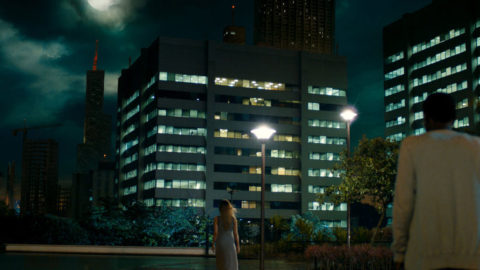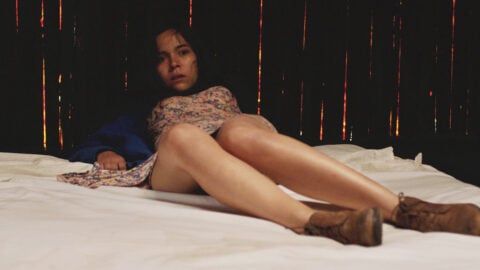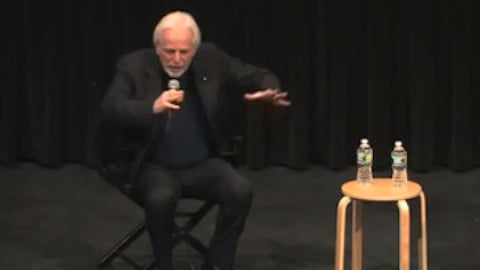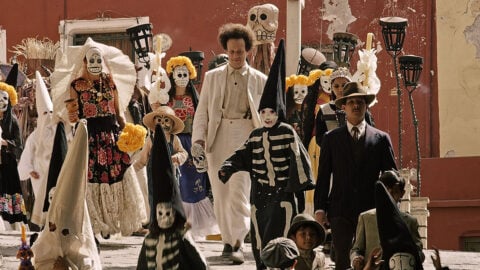Interview: Issa López
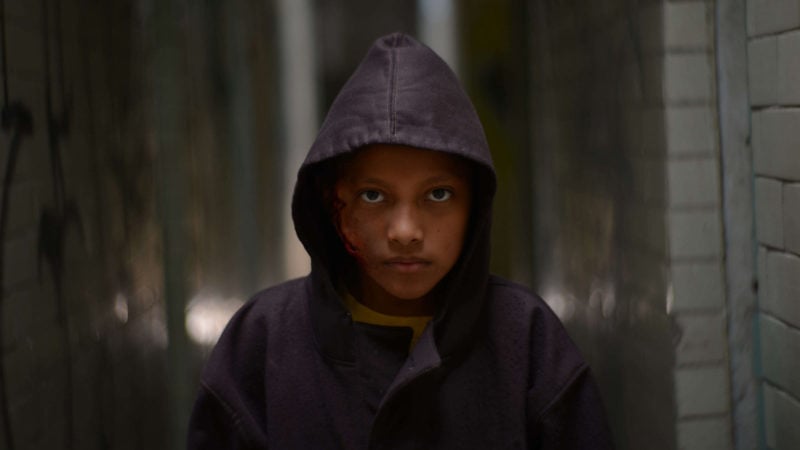
In director Issa López’s world, graffiti on city walls becomes a living, breathing entity, and ghosts walk among the living. The possibility that magic exists within us, and the simultaneous comfort and terror of imagination, comprises the crux of her new genre-bending film Tigers Are Not Afraid, which has captivated Guillermo del Toro, Stephen King, and many other viewers worldwide. Equally inspired by magical realism and hauntings real and imagined, the film plays like a documentary tinged with elements of the fantastical, and horror springing from unsuspecting corners.
In the film, a young woman named Estrella comes home one day to find her mother gone, a victim of abduction. She then joins a gang of boys in town, among them Shine and Morrito, who are also roaming around this deserted place, and trying to survive. The collection of stories is culled from the real-life tragedies of the ongoing drug war surrounding Ciudad Juárez, in López’s native Mexico.
Tigers Are Not Afraid took many years to make, and a while to be out in the world, too, after rejections from Sundance, Venice, and other film festivals, it found a home at the genre festival Fantastic Fest in 2017, and took off from there. It makes its New York premiere on August 21 in Scary Movies at the Film Society of Lincoln Center. López and I chatted over Skype and delved into the superstition and ghost stories particular to Latin America, humor as a means of survival, and how narcotrafficking is often romanticized on the screen.
I found myself immediately drawn to and haunted by the ghost stories in Tigers Are Not Afraid. Growing up in Latin culture, that lineage is something often we live with our entire lives.
Yes. And I’m glad that you’re Latin, and you understand that particular brand. I’m not saying that it doesn’t work internationally. I’ve been incredibly lucky with this movie after being incredibly unlucky, but now it’s all beautiful. I’ve been able to personally go to 18 of the festivals that it’s played at, maybe 19. And it’s incredible how some cultural cues are, and a culture that does not speak the language gets it sometimes. And a culture that sometimes understands the language, like Spain, gets one thing but doesn’t get another one. It’s so interesting to see what one culture connects with and the other one doesn’t.
What’s it been like watching Tigers Are Not Afraid with audiences all over the world?
The one thermometer that varies widely is humor. I did the [subtitle] translation myself to English, and I supervised the translation to French. It’s so interesting. I discovered that cultures that repress their feelings do not react to the humor beats in the movie. In spite of this pretty dark version of a fairy tale, and it going into very painful places, it’s Latin America. This is who we are. We can’t help—I can’t help—having a laugh here and there. For example, in Ireland, they laughed so hard in Belfast. I was not aware of how alive war and pain is in Belfast, it’s not a thing that we hear a lot about now, the conflict in northern Ireland. They understand being able to laugh in the middle of disaster. The Dutch? They didn’t laugh one single time. And they are fluent in English, so they could read the subtitles. The Koreans didn’t laugh one single time. And I watched it four times in Korea. It was incredible, not a giggle. In spite of that, the movie was a huge hit in Korea. It was a huge hit in Amsterdam. Because the emotional part of the movie, the thriller part of the movie, connected universally.
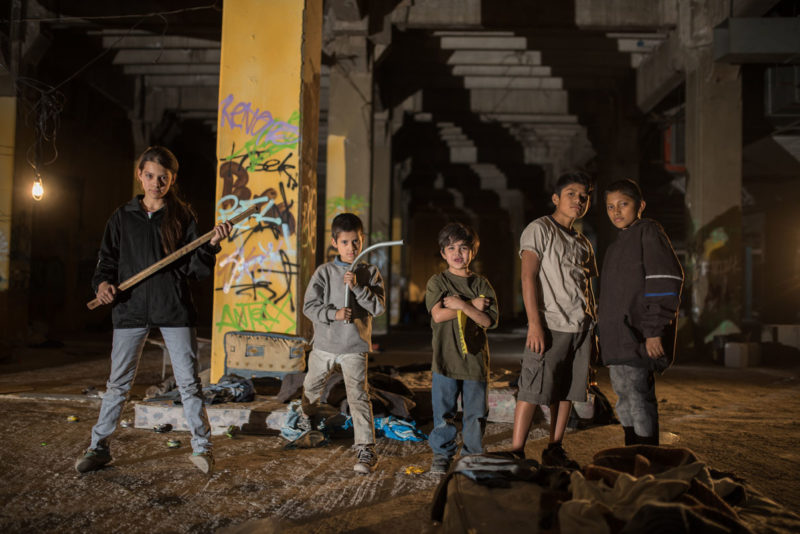
While watching this film, I was thinking a lot about humor and imagination as means of coping during crisis.
Yeah. The truth is, the past in Colombia, Venezuela, and a lot of Latin American countries is a very similar experience—you grow up in a culture that’s so ingrained in violence. And you know, Mexico has always been perceived universally—well, now that’s changing thanks to the drug war, and it’s horrible—as a fun-loving kind of place. And it is. But the truth is that even before the Spanish conquered Mexico, its history is made of war. Very very bloody, very very violent war, very very religious, very very magical. And completely obsessed with the concept of death. Or the dead being with us, or in constant communication with the dead.
And the type of war that ancient Mexicans went into was magical war, it was religious war. The prisoners were sacrificed in extremely violent ways. The Spanish get here, carrying on their shoulders the Inquisition and a very bloody version of Catholicism. We had centuries of domination with a lot of rebellions, and after that a very bloody independence. And after that independence, this ongoing war going to revolution, and a revolution that never really ended. And that in turn became the drug war. It’s a history of constant conflict. And the only way to cope with a history of never-ending conflict is survival. And the way to survive— for anybody that has been in the middle of conflict for a long time, and this can even be personal, with families that live in a violent environment—is the beauty of human spirit. Especially with children. It is incredible how they are able to find imagination and play in the midst of the most despairing conditions.
A lot of the images that I use in the movie are not mine. I took them from a very deep visual research, with what happens with children under those conditions. The beauty of it is is how you invariably can find children playing in a battlefield, you know? After a battle ends. You can find extremely poor children—that moment [in the film] where one of them draws the number of a soccer player on the naked back of the other? I saw a photograph of that and it blew my mind. And I saw a photograph of Mexican children playing with police tape after a crime scene. And I had to put it in the movie.
Were these images from Ciudad Juárez in particular?
It was in Juárez. A beautiful journalistic photograph. All of those images I collected during the years that it took to make the movie, and I was able to put them in. Some of them came from my children—not from my children, I’m not a mother, my children in the movie, my actors—letting them play and improvise once that we had established the horrible conditions their characters lived in. At the very beginning, they were in shock to try to pretend that this was the reality. And it’s tough. Then after a while they just went into it, and embraced it, and started playing with it. Because that’s what kids do, and that’s how they survive. And there’s a part of us that I believe never stops, hopefully, being a child. That part connects with the capacity to find all magic and superpowers, and to have wishes granted and to laugh in the middle of crisis.
For the script, did you also draw on your personal history with superstition and ghost stories you heard growing up?
Absolutely. Well, first of all, I lost my mother when I was eight years old. And in a way, the movie is that story. It’s not my particular circumstances, because I think my particular circumstances pale to what children survive in Mexico today go through. And I felt that their story was so much more worth telling than mine. But still, the structure is there. When you’re eight years old, and you come home and your mother is not there, and you never had a chance to say goodbye, strange, sad, and interesting things happen to the person you become.
So one of them is part of tribal rites that we’ve lost in our modern society. We’ve created a world where we are so away from death. We never see it happening. And once it happens, we do a lot of gymnastics to not face it, or face the actual dead body the way a dead body is supposed to look. Simply not go through the rituals that, for thousands of years we’ve been doing, since I think we were first aware that we die, and the people we love die. So that affected me deeply, the fact that I never had the chance to say goodbye. I never had a chance to be at the funeral—and I understand the decision, it’s hard to decide to have an eight-year-old look at a box where her dead mother is and then see that box buried. It’s a tremendously powerful moment. But in a way, you need to see that to understand that this person is really dead. And that she’s not somewhere, and that maybe you will run into her again.
And that manifests into a feeling you carry with you your entire life: That there’s a ghost following you, because you never said goodbye. And that’s a little bit what the movie is about. The movie is about a girl that comes home and her mother is not there. In her case, Estrella, my character, it is because her mother has been abducted as part of an ongoing and terrifying wave of violence against women that’s taken Mexico. And then she makes a little mistake of wishing—and she believes she has been granted three wishes. I believe she has been granted three wishes, too. That’s one of the questions in the movie: is this a thing that she’s imagining, or the magic is real? And audiences have to decide, and whatever they come out with is the truth. She makes a wish that her mother comes back, and Mom does come back. But from the grave—she’s dead. And she starts running away from the ghost because she doesn’t want to face it.
Now, the other thing that happens to you when you go through tragedy when you’re really young is that the realization that the world is not a nice place necessarily hits you very early. And when that happens, you start looking for and questioning what you see around you, and wondering if this is it. If this is all. That what we can see is all of it, or if there’s more. And if there’s stuff that is not as evident, and only manifests in certain circumstances. And then you start falling in love with ghost stories, because they point to the fact that death is not an end. And you start reading science fiction, because maybe the world is wider. Maybe there’s more in the future. And you start reading fantasy, because what about magic? Maybe if you wish really really hard, you know? So you start falling in love with genre. And that’s what happened to me.
And the other thing is, because I didn’t have a mother, and my father had to work, and we had nannies. Because of the social structure in Mexico, nannies back in the ’80s came from little towns outside Mexico City, where I grew up. Mexico, as is Latin America, is an incredibly superstitious country. And one of them came and told us a story, and it was about nahuales. And now I’m writing about that actually. Nahual is the animal spirit of witches, of brujos, in Mexico. They can shift shape and become an animal, as in many, many world traditions. Then she told us that the devil had once visited her hometown and he was a guy, and all of his teeth were gold. Images like that were stuck with me forever! The first question my sister and I would ask would be: “Tell us the story of witches or ghosts or devils in your town?” And we became obsessed with it! And all of that, growing up reading in the age of magical realism literature, when [Gabriel] García Márquez and Isabel Allende exploded, absolutely informed my work. And so you can see it in the movie.
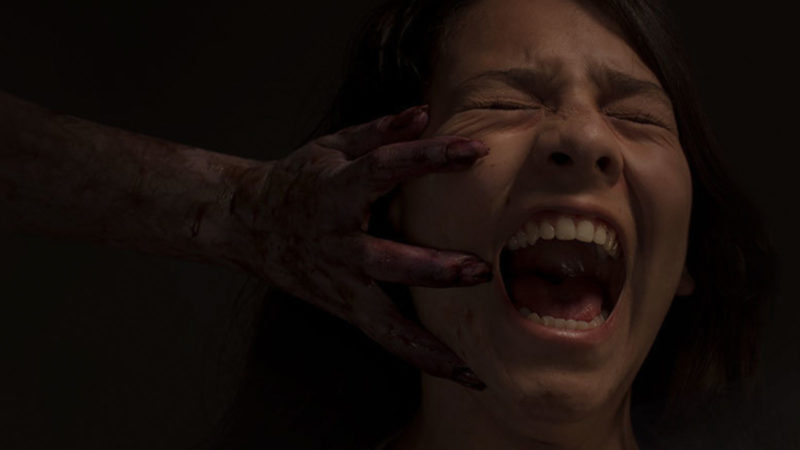
I read that the idea for Tigers Are Not Afraid came about when you were interviewing people for another film script, a historical drama about drug trafficking during World War II. How did it evolve from that initial research?
I was writing a script, as often happens in this business, of a movie that was not made. It was about the very origins of the cartels, how it all started during World War II. The U.S. needed someone to make opium for the U.S. Army during World War II, because Japan had blocked the routes of the southeast opium makers, and traffickers that usually provided for the morphine-making that the U.S. Army needed desperately. Suddenly they were in conflict in the Pacific and didn’t have morphine. And Mexico, around that time, declared war on Germany. Mexico was the natural route to get spice to the U.S. So it was a big deal. And the U.S. immediately made a deal with Mexico to produce opium in Sinaloa, because the climate was great and there was a large Chinese population there. They were already making a little opium, but it was not significant. So farmers that grew tomato and fruit in Sinaloa switched to poppy flower and a very successful industry that went throughout the war. Then, the war was over. And the U.S. turned to Mexico and said, “Thank you, that was awesome. Go back to tomato.” As American soldiers who were addicted to morphine were coming home. So no, that didn’t happen. And the cartels were born.
So I’m researching this story, and I’m talking to historians and journalists. And one of them, inevitably, when we were talking about what happened before, either in the beginning or closing the conversation, would go into what a complete fuckfest Mexico is now because of this little glitch. Right around that time, the last part of the drug war in Mexico had started which really made it explode. Which was that the president at that point, [President] Felipe Calderón had decided—in a tremendous act of hubris—that he could declare that drug trafficking was over. So he started arresting people and taking people, and the only thing that that achieved is all the desperate lieutenants, younger and bloodthirsty and ready to do anything, started growing and exploding. And that created chaos. People started disappearing right and left.
And then he said, “Of course, those poor little children.” And I just stood there like a deer in the landlights, and said, “What about the children?” And he said, “Well, people are disappearing, single mothers are disappearing, who is taking care of the children?” And he had people he knew in Juárez who were researching about it because it was out of control, simply the state has already failed in so many areas that they could not take care of this. And children were on their own, preyed upon by the cartels to become child soldiers. Or, you know, sold as prostitutes. There were even rumors of organ trafficking.
That’s horrifying.
Yes. By the way the movie, as bleak as it is, it doesnt go into the full extent. Because there were things that I learned in this research that, believe me, you don’t want in your head. Way, way worse than what I portrayed in the movie, because I didn’t feel it was necessary to convey the pain and the fear, to go all the way into madness. Because it is madness. So I stopped in my tracks and thought, “It’s crazy that I’ve never thought of this.” And the reason I had never thought of it is in spite of the insane abundance of entertainment made out of the drug war.
Like Narcos…
Narcos is that. I am sorry, I am so upset by Narcos. And the new season is Mexico, the drug war… I mean, you’re Colombian. The last season touched you personally, that’s your history. Mine is coming in the new season. Here’s what they’re portraying: guys, men, who came from nothing, and by violence became the kings of the world, pretty much. Got all the women, all the guns, and all of the crazy adventures, outsmarted everyone, then many of them were caught and killed. But who cares? Because by then you’re a king, you’re a hero, you’re a legend, and you go up in flames. And this is what they’re feeding the children in my country. Everything is about them and it’s glorifying them. That’s what they’re consuming! We’re normalizing this, romanticizing this. It is not right.
In a couple of hours, the sun sets in Mexico. If we look at how many people died today…even with that absolute flood of movies made and TV made and music made and entertainment made out of this, nobody, nobody, is talking about the children. I decided that I needed to tell a story about them, but I didn’t want to do an exposé. There’s a couple of gorgeous movies that have been about the drug violence in Mexico. I’ve seen them and I appreciate them. But they’re very naked, and very crude, and then they go into it without giving you any emotions to hold on to and work with when the movie’s over. And I felt that, first of all, I’m a storyteller and I’m a fiction writer. And I needed to find a story, a tale, to tell that could capture you and you could care and worry and walk out of the cinema feeling yes, very worried. Yes, very touched. But also give you a little bit of light. Because if I don’t do that, I feel that your audiences will say, “Oh, it’s terrible and there’s nothing we can do.” It was important to give a little bit of hope.
So I couldn’t find it immediately. I had to do one of those things where you wait for the story to come to you. I knew that I wanted to talk about that, but I didn’t know the story. It took me a while and then it hit me. I half wrote a short story when I was 16, I believe, I never finished it. It was about a little boy that wants to belong to a gang of boys, and they don’t let him. And I was like, “Oh, that’s a story.” I realized that one thing that I wanted to do all my life, and I hadn’t done before, was talk magic and genre and magical realism and ghosts. All of them mixed naturally with the story I was trying to tell.
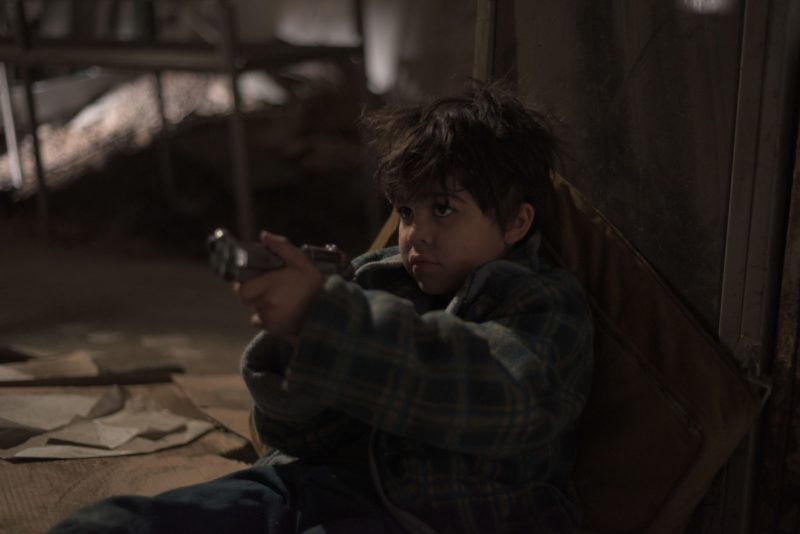
I know you moved back to Mexico to make this film after living in Los Angeles for a while, and this story has been in the works for even longer than that. I’m wondering what it was like writing about a place that’s intimate to you, but from a distance.
It felt like going back to your home where you grew up after many years of not visiting. I started my career as a fiction writer, many years ago. I didn’t know that I was going to go into cinema. I loved cinema but I didn’t know that. I started…I think I got my first short story award at 17 and then I wrote a bunch of short stories and got fairly successful in that, and then eventually I got into television and then cinema. I went to film school and wanted to get into cinema, but back then no movies were made in Mexico. Eight a year, when I was in film school. Writing Tigers felt so much like writing my short stories, because those were magical. God would visit, and the devil would visit, and ghosts would visit, and the dead would come back.
They were set deep in Mexico, and they were so infused with the things I grew up hearing from the nannies and all the traveling I did in Mexico. Because my father, who was a college professor… we were struggling. When you’re a college professor, you don’t make a decent living in Mexico. We didn’t have any money, so what my dad did is find all of the incredible smart ways to keep us amused, especially because he was not there during the day. He had to work. So we would go every weekend to road trip Mexico and go from small town to small town. Sitting to watch kung fu movies in the traveling cinemas on wheels in Mexico, and eating food in the depths of Veracruz, and visiting the most haunted bruja town in Veracruz.
So that was my childhood, and my short stories were made of that. And I hadn’t revisited that until I went back and made Tigers. And it was oddly easy. It didn’t feel like the muscles were stiff at all. It just flowed. That’s why I felt like I wasn’t even writing it at all—probably an older version of myself was writing it.
Did the tiger ever come up as a symbol or character in those early short stories you wrote?
You know, no. I have a short story about snakes taking over a town. Animals have always been a huge element of my fiction. Always. Even comedy. The story with the tiger is that as I was preparing my visuals for the movie, and for years and as I surfed the internet, whenever I see an image that strikes me, I create a Pinterest board. I was collecting those images and I knew that I wanted it to take place in a ghost town, in a ghost city, because that’s what’s happening in Mexico. That entire areas, and sometimes the towns themselves, end up being ghost towns because people leave or are killed. And in one of the photographs I saw there was this big, beautiful, gorgeous deer inside, I believe it’s an abandoned cathedral. And it just blew me away. I need this in my movie.
So I went to my producers and said, “Listen, I want a wild animal.” And it came together in the fact that drug lords, indeed, they go crazy in the way that Hearst did and they create these amazing theme parks of mansions for themselves. And a lot of them have zoos, and wild animals. And when they’re taken, authorities don’t know what to do with the lions and the tigers. That’s a true story. There’s that hippopotamus story in Colombia. And I thought, “What if, since the city is becoming deserted, one of the drug lords was killed and the animals escaped?” So I went to them and said, “I need a zebra.” In one of the scenes where Shine goes away alone and he does the graffiti for Morrito, he turns around and there’s a zebra that looks at him and walks away. That was my image. I thought it was pretty cool. And they say, “Okay,” and they looked and say they have no zebras. And I said, “What? The entire Mexican film industry doesn’t have a zebra?” And they said, “No, no, we don’t. But we can get you a hippo.” [Laughs] “And I said, “Go back and bring me a list of wild animals and see what you can get.” And they sent in the list. And I saw the tiger. I realized that the tiger is too much of a symbol universally to be an animal that you see walking down the street and disappearing. And it slowly became the center of the story.
Paula Mejía is a writer, journalist, and the author of a 33 1/3 book on The Jesus and Mary Chain’s Psychocandy. Her work has appeared in The Criterion Collection, NPR, The New York Times, Rolling Stone, and other publications.



